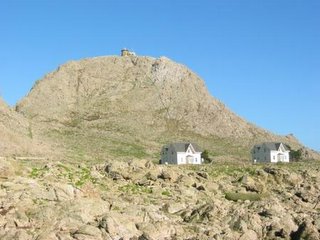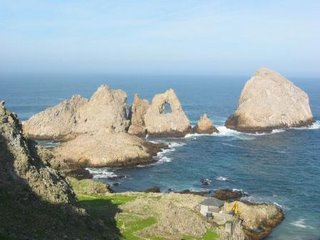 First Cow (-20) is an old and experienced mother. Schnitzel is not. Schnitzel abandoned her pup one day after it was born, the same as she did last year, but last year she had a large wound that gave her some rationale in our eyes for the abandonment. Last year, her pup perished, as it is impossible for a pup to exist without a mother to defend and feed it. This year, First Cow adopted the abandoned pup and began nursing it as well as her own. One of the interesting features of elephant seal society is the pup adoption phenomenon. Pups are often separated from their mothers, abandoned, or crushed in the confusion of the crowded colony, but cows that have lost their pups are very eager to adopt newly motherless pups. We have found that younger cows are more likely to lose their pup, due to their inexperience and low social rank. However, cows that have lost their pups are very eager to adopt a new pup, sometimes even trying to steal pups from their rightful mom. It is a rare event that a cow with her own pup will accept another and suckle it as her own, but that is what First Cow is doing. Normally, the energetic demands of raising one pup is enough to tax a cow's fat stores. It appears that this is a very good year in terms of cow energy supplies. The pups that have been born this year are 10% heavier than pups born last year, indicating that the cows had plenty of rich food to eat while they were at sea putting on blubber and gestating these pups. Apparently, First Cow felt fat enough this year to raise two pups instead of the ususal one, indicating that the past year was great in terms of e-seal food supplies.
First Cow (-20) is an old and experienced mother. Schnitzel is not. Schnitzel abandoned her pup one day after it was born, the same as she did last year, but last year she had a large wound that gave her some rationale in our eyes for the abandonment. Last year, her pup perished, as it is impossible for a pup to exist without a mother to defend and feed it. This year, First Cow adopted the abandoned pup and began nursing it as well as her own. One of the interesting features of elephant seal society is the pup adoption phenomenon. Pups are often separated from their mothers, abandoned, or crushed in the confusion of the crowded colony, but cows that have lost their pups are very eager to adopt newly motherless pups. We have found that younger cows are more likely to lose their pup, due to their inexperience and low social rank. However, cows that have lost their pups are very eager to adopt a new pup, sometimes even trying to steal pups from their rightful mom. It is a rare event that a cow with her own pup will accept another and suckle it as her own, but that is what First Cow is doing. Normally, the energetic demands of raising one pup is enough to tax a cow's fat stores. It appears that this is a very good year in terms of cow energy supplies. The pups that have been born this year are 10% heavier than pups born last year, indicating that the cows had plenty of rich food to eat while they were at sea putting on blubber and gestating these pups. Apparently, First Cow felt fat enough this year to raise two pups instead of the ususal one, indicating that the past year was great in terms of e-seal food supplies.PRBO has had the priveledge of working on the Farallones since 1965. We have observed the many species of seabird and marine mammal that breed here for 40 years. These datasets are some of the longest runs of biological data in the world, and they allow us to see how the ocean has changed over that time period through changes in the animals. The scientific research we conduct informs the managers at the US Fish and Wildlife Service, National Oceanic and Atmospheric Administration, and other agencies around the country, and the world so the rich biological treasures of the Farallones and elsewhere can be preserved for future generations. We increase our understanding of how the ecosystems of this planet function through science, and long-term data such as we collect at the Farallones offer rare insight into how ecosystems change through time.









